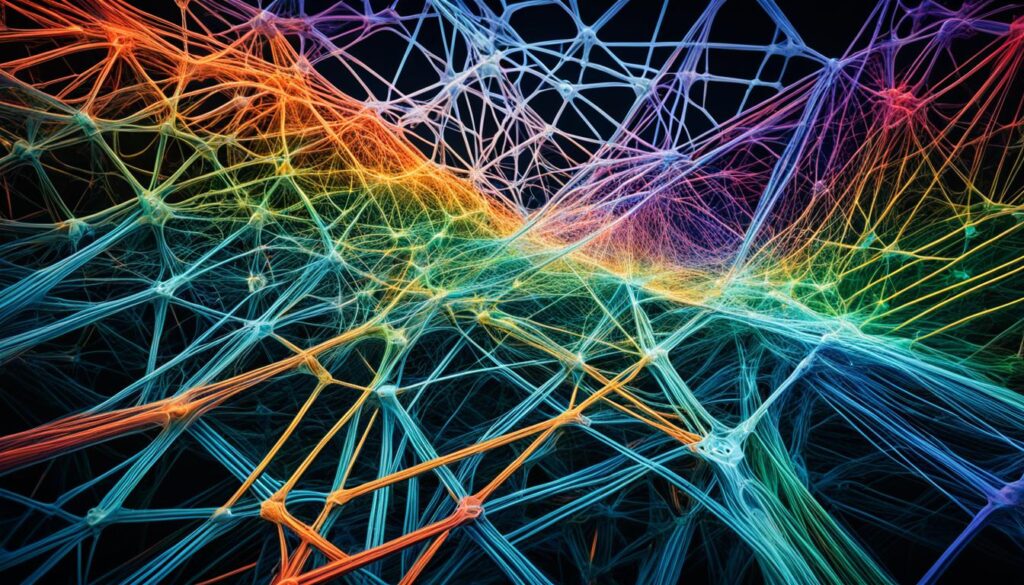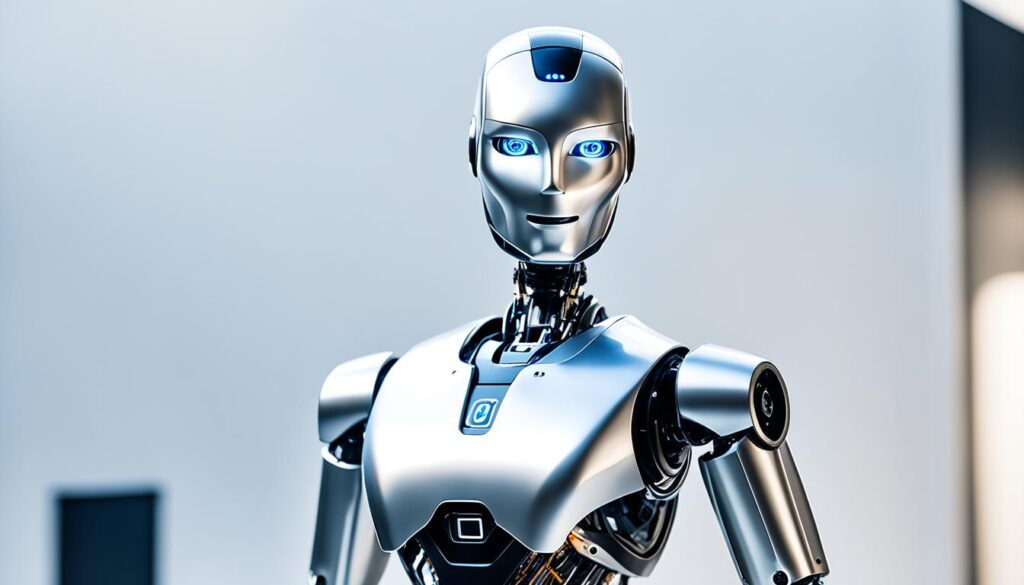Imagine a world where advanced artificial intelligence and cutting-edge robotics come together. This creates a humanoid that makes us rethink the line between technology and humanity. OpenAI, a leading AI research company, has made this a reality with its latest creation. This AI-powered humanoid robot marks a huge step forward in the world of smart machines.
The team at OpenAI has developed this cutting-edge humanoid robot. It shows off the amazing things AI and robotics can do. With its ability to understand and talk like us, and its ability to act on its own, this robot could change how we work and live with smart machines.
Key Takeaways
- OpenAI’s latest humanoid robot pushes the boundaries of AI and robotics, blurring the lines between technology and humanity.
- This advanced android features remarkable computing capabilities, natural language processing, and autonomous systems.
- The humanoid robot has the potential to revolutionize industries and transform our interactions with intelligent machines.
- The development of this cutting-edge technology represents a significant leap forward in the field of human-like androids.
- OpenAI’s cutting-edge AI and robotics expertise are showcased in this groundbreaking humanoid creation.
Introducing OpenAI’s Groundbreaking Humanoid Robot
OpenAI’s newest humanoid robot shows how the company is leading in artificial intelligence and robotics. It uses the latest in deep learning and neural networks. This robot does things that were once thought only possible for humans.
Pushing the Boundaries of Artificial Intelligence
The robot’s Anthropic AI system is a big step forward. It lets the robot understand language, see like a human, and make decisions on its own. This makes working with the robot feel natural. Its computing power and ability to learn new tasks make it a big deal in advanced technology.
Anthropic AI: Cutting-Edge Technology in Action
Using Anthropic AI, OpenAI’s humanoid robot is changing the game. It’s all about making new technologies that can change the way we work and live. By using neural networks and deep learning, this robot is set to change how humans and machines work together. It’s opening up new possibilities for artificial intelligence and robotics.
“The emergence of GPT-3 in 2023 led to the rise of hundreds of application-layer large language model (LLM) companies. Industries like computational biology, corporate data, and healthcare are expected to be transformed by companies utilizing large language models.”
Unlocking New Frontiers with Humanoid Robots
Humanoid robots, like OpenAI’s latest model, have huge potential across many industries. They have amazing computing power. This comes from powerful processors and strong software. They can do complex tasks very efficiently and precisely.
This makes humanoid robots ready to change how we solve challenges.
Advanced Computing Capabilities
These robots have a complex network of advanced computing at their core. They use the latest processors and software. This lets them handle a lot of data, run complex algorithms, and make decisions fast and accurately.
This power helps them do many tasks, from solving hard problems to working well with humans.
Ethical AI and Human-Robot Interaction
Humanoid robots also focus on ethical AI. This ensures safe and meaningful interactions with humans. It helps us move towards a future where humans and machines work together well.
They can understand natural language and make decisions on their own. This is a big step towards better relationships between humans and machines.
| Key Statistic | Value |
|---|---|
| Records from Nasher Museum’s collection integrated into ChatGPT | Over 14,000 |
| Themes proposed by ChatGPT for the exhibition | Dreams, subconscious, utopia, dystopia |
| Challenges faced by ChatGPT in accurately selecting appropriate pieces | Limitations of AI’s knowledge |
| Difficulties in exhibition layout planning due to AI’s limitations | Impractical suggestions |
| Potential of generative AI in curating art exhibitions | Case study from Nasher Museum’s initiative |
The future looks bright as we explore the power of humanoid robots. They bring together advanced computing and ethical AI. This will lead to big changes in industries, improve how we interact, and help humans and machines live together better.
OpenAI’s Newest AI Humanoid Robot
OpenAI’s latest AI-powered humanoid robot is a big step forward in technology. It combines AI, robotics, and computer vision in a new way. This robot looks and acts like a person, showing us what the future of humans and machines might be like.
This robot can talk to us in a natural way, answering questions on many topics. Studies show that people use AI like ChatGPT a lot for fun and companionship.
The tech inside this robot is amazing. It uses advanced neural networks to think and make decisions like a human. OpenAI’s SearchGPT is a new search engine that uses AI to find information better, showing how far AI has come.
This robot is a big deal for the future of robots and AI. It shows how far we’ve come in making machines that work like us. This robot is a big step towards making machines that work with us better.

This robot has grown thanks to new tech. NVIDIA’s AI supercomputers help make and train robots. NVIDIA’s AI tools make it easier to work with robots, speeding up how fast we can make new things.
OpenAI’s robot makes us think about the future of working with machines. But, with new tech in AI and vision, these machines could change our lives a lot.
Harnessing the Power of Neural Networks and Deep Learning
OpenAI’s humanoid robot is powered by the amazing technology of neural networks and deep learning. These artificial intelligence tools work like the human brain to handle lots of data. They let the robot learn from its actions and change with new situations.
Thanks to these top-notch technologies, OpenAI’s robot has incredible thinking skills. It can move around, talk to people, and make choices like a human would.
The robot’s neural networks work super fast, finding important info in big datasets. Deep learning helps the robot get better by learning from its mistakes and feedback.
“The fusion of neural networks and deep learning has truly revolutionized the field of artificial intelligence, enabling us to push the boundaries of what’s possible with humanoid robots.”
As technology gets better, neural networks and deep learning will be key in robotics and AI’s future.

Anthropomorphic Robots: Blurring the Lines Between Human and Machine
OpenAI’s latest humanoid robot is a big step towards making humans and machines closer. These anthropomorphic robots look and act like humans, changing what we think artificial intelligence can do.
Natural Language Processing and Computer Vision
Thanks to natural language processing and computer vision, these human-like robots can talk to us easily, understand their world, and make choices on their own. These technologies, along with advanced robotics, let us create robots that mix the digital and real worlds.
Autonomous Systems and Advanced Robotics
Autonomous systems and advanced robotics are key to these robots. They make these machines more independent, flexible, and able to make decisions. This makes the line between humans and machines fade even more.
The world of anthropomorphic robots is growing fast. These human-like robots could change many industries and our everyday lives. They bring together natural language processing, computer vision, and autonomous systems in advanced robotics.
“The development of humanoid robots represents a significant leap in the convergence of artificial intelligence and physical embodiment, challenging our traditional notions of what it means to be human.”
| Metric | Value |
|---|---|
| Total reads of the article “The cryptoterrestrial hypothesis: A case for scientific openness to a concealed earthly explanation for Unidentified Anomalous Phenomena” | 56,544 |
| Number of authors | 3 |
| Tim Lomas’s publications | 234 |
| Brendan Case’s publications | 12 |
| Michael Paul Masters’s publications | 18 |
| Michael Paul Masters’s citations | 194 |
The Future of AI: Endless Possibilities and Challenges
AI and robotics are changing our world fast. They’re set to transform healthcare, manufacturing, education, and entertainment. These technologies have huge potential to change our lives.
Humanoid robots, like the latest from OpenAI, are exciting. They’re making us rethink what’s possible by mixing human and machine traits. As they get better, they’ll work in many areas, doing tasks with great skill and speed.
But, these new techs bring big challenges. We worry about privacy, bias, and jobs lost to AI. The use of AI in the military also raises tough questions about war and responsible tech use.
The future of artificial intelligence and robotics is full of both good and bad. We need to work on ethical rules, help workers adapt, and make sure everyone benefits from these changes.
“Automation crises brought about by AI are seen as potentially pushing individuals towards pursuing socially impactful work, as advocated by Dutch historian Rutger Bregman with his movement for ‘moral ambition.'”
The future of AI and robotics is exciting but also tricky. By tackling the challenges and seeing the possibilities, we can make sure these techs help us, not hurt us.
Conclusion
OpenAI’s newest AI humanoid robot marks a big step forward in artificial intelligence and robotics. It has amazing skills in natural language, computer vision, and making decisions on its own. This could change how we talk to smart machines. As humans and machines get closer, robots like this one open new doors but also bring up big questions about ethics and society.
The future of AI and robotics looks thrilling, thanks to OpenAI’s new robot. It shows how fast and how much these technologies can grow. As we explore what’s possible with artificial intelligence and robotics, we must think about the right way to use these tools. The path ahead is full of hope, and we’re eager to see how OpenAI’s newest AI humanoid robot and other AI advances will change our world.



